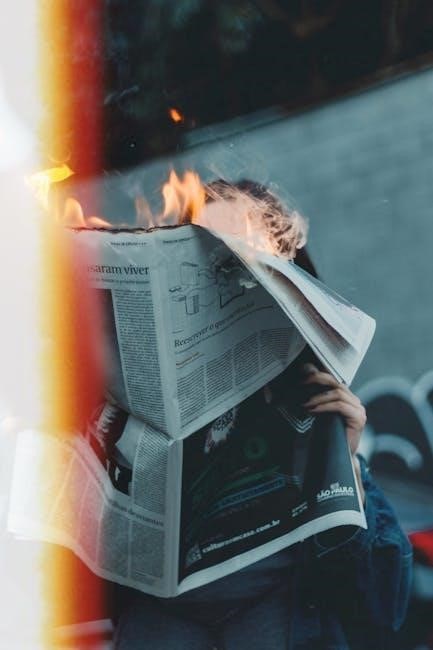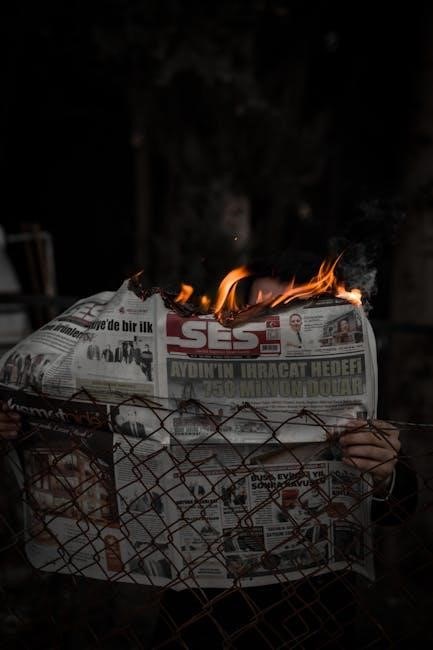
1.1 Overview of 3G Jet Opaque Heat Transfer Paper
3G Jet Opaque Heat Transfer Paper is a high-quality inkjet-printable material designed for transferring vibrant designs onto both light and dark fabrics with ease and precision.
3G Jet Opaque Heat Transfer Paper is a premium inkjet-printable material designed for transferring vibrant, full-color images onto both light and dark fabrics. It is specifically coated to ensure crisp, durable prints with excellent color retention. Ideal for custom T-shirts, this paper works seamlessly with most desktop inkjet printers. The process involves printing, cutting, and heat pressing the design onto the fabric. Known for its ease of use, 3G Jet Opaque is a popular choice for crafting and professional applications. It offers a cold peel feature, making it convenient for users to achieve high-quality results consistently.
1.2 Importance of Following Instructions
Adhering to the instructions for using 3G Jet Opaque Heat Transfer Paper is crucial for achieving professional-quality results. Proper temperature, time, and pressure settings ensure vibrant, long-lasting designs. Incorrect heat press settings or improper peeling techniques can lead to faded or peeling images. Following guidelines for printing, cutting, and pressing helps prevent common issues like ink bleed or poor adhesion. Additionally, washing instructions, such as waiting 24 hours before laundering, are vital for design durability. By following the recommended steps, users can consistently produce sharp, colorful designs, making this product ideal for both crafting and professional applications.

Features and Benefits
3G Jet Opaque Heat Transfer Paper offers vibrant, full-color prints on both light and dark fabrics. Compatible with most inkjet printers, it ensures sharp, durable designs for custom apparel and crafts.
2.1 Key Characteristics of 3G Jet Opaque Paper
3G Jet Opaque Heat Transfer Paper is designed for vibrant, full-color prints on both light and dark fabrics. It is compatible with most inkjet printers and offers a cold peel feature, ensuring easy transfer without damaging the design. The paper is durable, with a smooth, coated surface that prevents ink bleeding. Ideal for custom apparel, it works well with heat presses and hand irons. The paper supports medium pressure and temperatures between 350°F and 400°F. Washable and long-lasting, it retains color vibrancy and adhesion when properly cared for. This makes it a versatile choice for DIY projects and professional applications alike.
2.2 Compatibility with Inkjet Printers
3G Jet Opaque Heat Transfer Paper is specifically designed for use with most desktop inkjet printers, ensuring compatibility and ease of use. It works seamlessly with standard printer settings, requiring no special adjustments for high-quality prints. The paper is optimized for vibrant color reproduction and sharp details, making it ideal for custom designs. Simply print your image on the coated side, following the manufacturer’s instructions, and achieve professional results. Its compatibility with inkjet technology makes it accessible for both DIY enthusiasts and small businesses, offering a reliable solution for fabric transfers without the need for specialized equipment.
2.3 Versatility for Dark and Light Fabrics
3G Jet Opaque Heat Transfer Paper is uniquely designed to work seamlessly on both dark and light fabrics, offering exceptional versatility for various projects. Its opaque coating ensures vibrant colors on dark materials without requiring white ink, while maintaining crisp details on lighter fabrics. This adaptability makes it ideal for a wide range of applications, from custom T-shirts to intricate designs on colored textiles. Whether you’re creating bold graphics for black garments or subtle patterns for pastel shades, this paper delivers consistent results, making it a versatile choice for crafters and professionals alike;

Printing Instructions
Print your design on the coated side of 3G Jet Opaque Paper using an inkjet printer. Ensure the image is right-reading and not mirrored for proper transfer.
3.1 Materials Needed for Printing
To begin, ensure you have the following materials:
- An inkjet printer compatible with heat transfer paper
- 3G Jet Opaque Heat Transfer Paper
- Your desired digital design or image
- A computer with printing software
- Scissors or a cutting tool for trimming
- A smooth, flat surface for printing
These tools are essential for achieving high-quality prints that are ready for heat transfer applications.
3.2 Printer Settings and Calibration
Proper printer settings are crucial for achieving optimal results with 3G Jet Opaque Heat Transfer Paper. Start by ensuring your image is not mirrored, as this paper requires a right-reading print. Select the appropriate paper type, often labeled as “heat transfer paper” or “photo paper,” depending on your printer. Choose a high-quality print setting to ensure vibrant colors. Adjust the color mode to CMYK if necessary, and ensure you print on the coated side of the paper, which is typically duller. Allow the ink to dry completely before proceeding. For best results, consult your printer’s manual for specific settings and calibration recommendations.
3.3 Design Tips for Optimal Results
For optimal results with 3G Jet Opaque Heat Transfer Paper, ensure your design is high-resolution and vibrant. Use contrasting colors to enhance visibility, especially on dark fabrics. Avoid overcomplicating designs, as intricate details may not transfer cleanly. Trim unprinted areas around the design to prevent excess paper from interfering during pressing. Ensure text is mirrored if required, but note that 3G Jet Opaque typically requires a right-reading print. Test designs on scrap fabric first to confirm colors and alignment. This ensures professional-looking transfers every time, whether for personal projects or commercial use.

Application Instructions
Apply the transfer at 350°F to 400°F for 30 to 35 seconds with medium to heavy pressure. Peel the paper while it’s cold for the best results.
4.1 Preparing the Garment
Ensure the garment is clean, dry, and free of wrinkles. Preheat the fabric for a few seconds to remove moisture and ensure proper adhesion. Place the garment on a smooth, hard surface, such as an ironing board, and cover it with a sheet of parchment paper or an ironing sheet to protect it from heat and moisture. Position the transfer paper with the image facing up, centered on the garment. Avoid using steam, as it can damage the transfer or the garment. Proper preparation ensures a smooth and even application of the design.
4.2 Using a Heat Press
Preheat the heat press to 350°F (175°C). Place the prepared garment on the press, ensuring it’s centered and smooth. Position the transfer paper with the image facing up, aligning it carefully. Apply medium to heavy pressure and close the press. Set the timer for 30 seconds. Once done, allow the garment to cool slightly before peeling the transfer paper. For best results, follow fabric-specific guidelines and wait 24 hours before washing. Practice on a test garment first to ensure optimal results.
4.3 Hand Ironing Instructions
For hand ironing, preheat the iron to its highest setting without steam. Place the transfer on the garment, image side up, and cover with a heat-resistant sheet. Iron firmly, applying consistent pressure for 30 seconds. Ensure the iron glides smoothly over the entire design. Allow the transfer to cool slightly before peeling the paper. Hand ironing is best for small designs and light fabrics. For optimal results, test on a scrap fabric first to ensure proper adhesion. Avoid using steam, as it can damage the transfer. Wait 24 hours before washing to ensure the design sets properly.
Cutting and Peeling
Cutting and peeling are crucial steps for achieving clean edges and proper adhesion. Use scissors or a cutter to trim excess paper around the design. Peel the transfer slowly after heat application to ensure the design adheres properly to the fabric. This step ensures a professional and durable finish for your projects.
5.1 Cutting Techniques for Clean Edges
To achieve clean edges, cut along the design’s perimeter without leaving a margin. Use sharp scissors, a craft knife, or a contour cutter for precise cuts. For intricate designs, a plotter cutter is recommended. Ensure the blade is sharp to prevent jagged edges, as this can compromise the transfer’s quality. Cut on a flat, stable surface, and use a ruler for straight lines. Avoid cutting too close to the image, as this may lead to loss of detail. Smooth, steady motions are key for professional-looking results. Proper cutting ensures the design adheres evenly during heat transfer, eliminating excess paper that could cause unwanted edges.
5.2 Peeling Methods for Different Fabrics
Peeling methods vary based on fabric type and thickness. For most fabrics, a cold peel is recommended after heat transfer. Allow the paper to cool slightly, then gently peel it back at a 45-degree angle. For thicker or stretchy fabrics, a hot peel may be necessary, peeling immediately while the transfer is warm. Use a craft stick or similar tool to assist with stubborn areas. Avoid pulling too aggressively to prevent lifting the design. For delicate fabrics, peel slowly and carefully to maintain integrity. Always test peeling techniques on scrap fabric first to ensure optimal results.
Washing and Care Instructions
Turn garments inside out before washing. Use cold water and mild detergent. Avoid bleach or fabric softeners. Air dry or tumble dry on low heat to preserve designs.
6.1 Recommended Wash Settings
To maintain the quality of your designs, wash garments inside out using cold water (maximum 105°F or 40°C) and a mild detergent. Avoid bleach or fabric softeners, as they can damage the transfer. Do not iron directly on the image. Allow 24 hours before the first wash to ensure the design sets properly. Tumble dry on low heat or line dry to prevent fading. Following these guidelines will help extend the life of your design and keep it vibrant for a longer period.
6.2 Tips for Longevity of the Design
To ensure your design lasts longer, store the garment properly before the first wash, allowing the design to fully set. Avoid stretching or folding the fabric near the design to prevent cracking. Use a gentle detergent and avoid fabric softeners, which can weaken the adhesive. For ironing, use a low setting and iron inside out, avoiding direct contact with the design. Hand washing is recommended for delicate fabrics to minimize abrasion. By following these care tips, you can enjoy your vibrant designs for an extended period, maintaining their quality and appearance.
Troubleshooting Common Issues
Common issues include faded designs, peeling, or poor adhesion. These are often due to incorrect temperature, pressure, or wash settings. Refer to the user guide for adjustments.
7.1 Solving Print Quality Problems
Print quality issues with 3G Jet Opaque Heat Transfer Paper often stem from incorrect printer settings or improper handling. Ensure the image is printed on the coated side and not mirrored. Using the wrong paper profile or low-quality ink can also cause faded or blurry designs. To resolve this, calibrate your printer, clean the print head, and use high-quality inkjet ink. Verify that the paper is loaded correctly and the printer settings match the paper type. If issues persist, refer to the printer’s manual or contact customer support for assistance. Proper calibration and maintenance can significantly improve print clarity and vibrancy.
7.2 Addressing Adhesion Issues
Adhesion issues with 3G Jet Opaque Heat Transfer Paper can occur due to incorrect heat press settings or improper preparation. Ensure the garment is clean, dry, and free of wrinkles. Verify that the heat press temperature is set between 350°F and 375°F (175°C to 190°C) with medium to heavy pressure. Peel the paper too soon or too late can also cause adhesion problems. For cold peeling, wait at least 30 seconds after pressing. If the design doesn’t adhere properly, check the fabric type and ensure it’s compatible. Re-pressing at the correct settings may resolve the issue. Always follow the recommended time and temperature guidelines for optimal results.

Comparisons with Other Heat Transfer Papers
3G Jet Opaque excels in versatility, working on both light and dark fabrics with vibrant results, surpassing other heat transfer papers in ease and quality.
8.1 Differences in Performance
3G Jet Opaque Heat Transfer Paper outperforms other papers due to its compatibility with both light and dark fabrics, delivering vibrant, long-lasting images. Its unique coating ensures minimal ink absorption, preserving color intensity. Unlike some alternatives, it avoids fading after washing and maintains adhesion without cracking. The paper’s smooth finish reduces wrinkles, making it ideal for intricate designs. While other papers may require additional coatings or treatments, 3G Jet Opaque works seamlessly with standard inkjet printers. Its durability and ease of use make it a top choice for professionals and hobbyists alike, ensuring consistent results across various fabric types.
8.2 Cost-Effectiveness Analysis
3G Jet Opaque Heat Transfer Paper offers exceptional value for its price, combining high-quality performance with affordable costs. Compared to other papers, it provides consistent results without requiring additional treatments or specialized printers. While initial costs may seem higher, its durability and resistance to fading ensure long-term savings. The paper’s versatility for both light and dark fabrics reduces the need for multiple products, making it a cost-effective solution. Additionally, its compatibility with standard inkjet printers eliminates the expense of specialized equipment. Overall, 3G Jet Opaque balances quality and affordability, making it a budget-friendly choice for professionals and DIY enthusiasts alike.

Safety Precautions
Use protective gloves and eyewear when handling hot equipment. Ensure proper ventilation to avoid inhaling fumes. Keep heat presses away from flammable materials and children.
9.1 Heat Press Safety Guidelines
Always preheat the heat press in a well-ventilated area, away from flammable materials. Use a temperature range of 350-400°F for optimal results. Ensure the press is placed on a heat-resistant surface. Keep children and pets away during operation. Avoid touching the hot platen or surfaces with bare hands. Use thermal-resistant gloves if necessary. Never leave the heat press unattended while in use. Regularly inspect the machine for worn-out parts and ensure proper maintenance. Turn off the press when not in use and allow it to cool before storing. Follow the manufacturer’s guidelines for pressure and temperature settings to prevent accidents and ensure safe operation.
9.2 Handling Chemicals and Materials
When handling chemicals and materials for 3G Jet Opaque Heat Transfer Paper, use protective gloves and eyewear to avoid skin and eye irritation. Store all chemicals in a well-ventilated area, away from direct sunlight and moisture. Ensure the workspace is clean and free from dust to prevent contamination. Follow the manufacturer’s instructions for any cleaning solutions or additives. Avoid using harsh detergents or abrasive materials that could damage the transfer paper. Properly dispose of unused chemicals and materials according to local regulations. Keep the heat transfer paper away from direct sunlight and store it in a dry, cool environment to maintain its quality and performance.
3G Jet Opaque Heat Transfer Paper is a versatile and durable solution for creating vibrant designs on both light and dark fabrics, ensuring long-lasting results when instructions are followed carefully.
10.1 Summary of Key Instructions
To achieve optimal results with 3G Jet Opaque Heat Transfer Paper, follow these essential steps: print your design on the coated side, avoid mirroring the image, and use a contour cutter or scissors to cut out the design. Preheat the garment, apply medium to heavy pressure at 350°F (175°C) for 30 seconds using a heat press, and peel the paper while it’s cold. For hand ironing, use the highest heat setting without steam and iron on a firm surface. Allow the design to set for 24 hours before washing, and wash inside out in cold water without bleach for longevity.
10.2 Final Tips for Success
To ensure the best results with 3G Jet Opaque Heat Transfer Paper, always preheat your garment before pressing and avoid using steam during ironing. Use medium to heavy pressure for optimal adhesion, and allow the design to cure for at least 24 hours before washing. Cut precisely along the design edges to minimize excess paper, and consider testing on scrap fabric first. For longevity, wash garments inside out in cold water without bleach. Following these tips will help achieve vibrant, durable designs that withstand repeated washing and wear.



